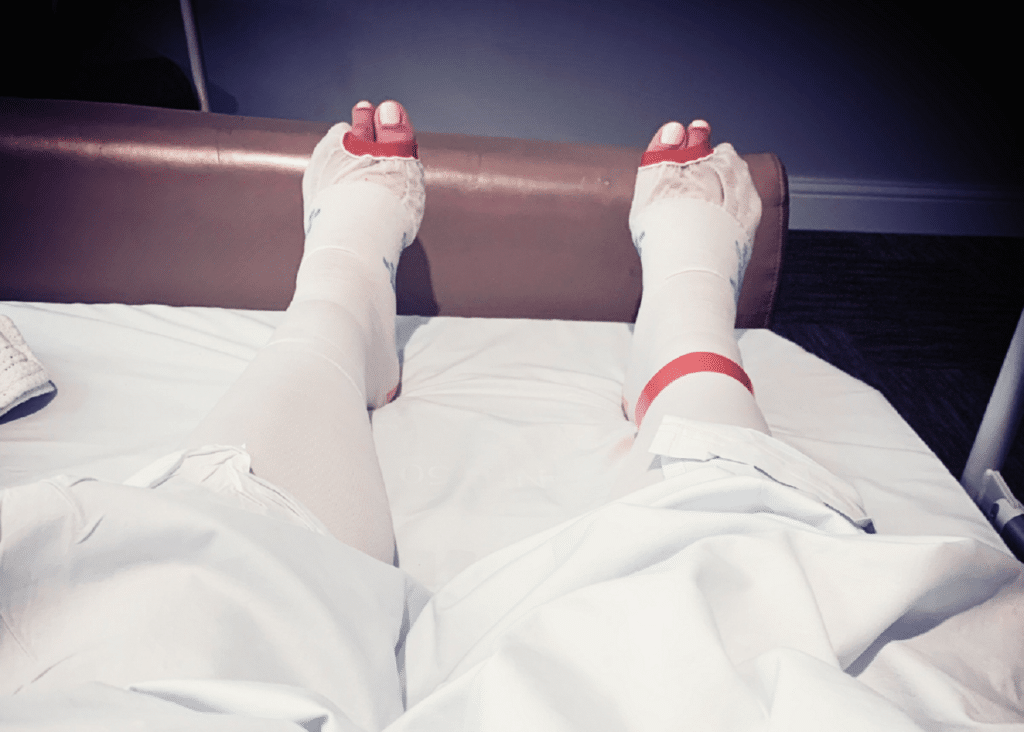As I stared down my hospital bed to my compression stockinged feet, I listened to my surgeon detail all the places he’d found endometriosis… Urethra, Pouch of Douglas, Uterus, Rectum, Vagina… “Stage 3,” he told me.
It was 2020 …14 years after I’d first been diagnosed with endometriosis…at 38, this had been my fourth surgery for endometriosis, and it was the first time a specialist had bothered to look outside my uterus. It was also nearly 30 years since I’d first experienced debilitating pelvic pain as a child…and all I’d ever been given were bandaids for bullet holes.
Pelvic pain, my long and faithful companion since childhood. I don’t remember when it didn’t exist – although I am sure there must have been a time when it didn’t lurk in the shadows of my life.
I grew up in a household in Sydney with a paediatric nurse as my mother and an ex-ambulance officer as my father. My brothers and I were brought up with a healthy dose of reality about the relative ease of our lives compared to those in the hospital. As adults, we joke now about how we had to be dead to get a day off school.
That being said, when I was in primary school, the regular occurrence of left-sided pain deep within my pelvis was something to be examined. After several visits for the same complaint, my family GP commented that if it were on the other side, he would think it was appendicitis; however, it ‘must be’ a food-related issue, the first bandaid solution. Perhaps I ‘should try and see if anything sets it off’. Nothing ever did.
Fast forward to my teens, and I was back in that same GP office; the persistent pelvic pain continued, and now I had menstruation to add to the mix. I experienced the heavy menstrual bleeding that required the deployment of the full force of available sanitary reinforcements…super tampons, surf-board pads, ‘scungies’ over my undies and two-hourly trips to the loo for the changing of the guard.
“I think we’ll put you on the pill. You will find that probably helps.”
And so, as a teenager, under the recommendation of my GP, bandaid #2 was applied, and I began my relationship with hormones designed to change how my body acts.
The only thing the pill fixed (other than some later-in-life benefits of contraception) was the predictability of when I would need to arm myself with supplies. My afternoon lessons in classical ballet were always tricky to navigate. As we were only allowed to wear tights and a leotard – contending with heavy, painful bleeding and keeping it all out of sight was traumatic…after all, ‘periods were embarrassing’ and something we didn’t talk about openly.
The inexorable advance of pain had become such a regular part of my life that by the late 1990’s I had resigned myself to its permanency. Excruciating lower back pain, a uterus that felt like it would fall out and that niggling pain in my left side. I was now in a serious monthly relationship with prescribed bandaid # 3 – Naproxen, and I would only cheat on it when the pain was more manageable.
The problem was, it was a lousy partner – only dulling the edges of the pain and doing nothing to take it away. By the time I was 21, sex was unbearably painful; instead of gripping my partner in pleasure, I would be gripping in pain, doing everything I could not to scream out in agony. My friends talked about orgasms and wild nights… I was embarrassed…sex had never felt comfortable, and in my naivety, I thought there was something wrong with me, so I kept my mouth shut and my grip firm.
Things began to unravel in 2006 when I stood out of bed one morning, and blood gushed from my body like I had been wounded in some mortal way. This time, I knew something wasn’t right. After a call to Mum, my personal on-call medical advisor, my then-boyfriend (now husband) Nick took me to the emergency department. I was told initially, “it must be an STI”, before being incorrectly informed I was going through a miscarriage, until finally, many tests and scans later, it was discovered that a 10cm dermoid cyst was growing on my left ovary.
Following the operation to remove it, the specialist commented that he had found some Endometriosis in my uterus, so bandaid #4 was to remove those lesions while he was there. I had no idea what that was, but I was told it wasn’t likely I’d conceive easily, and my GP informed me, “it turns out that left-sided pain you’ve had since childhood was this cyst growing … you would have had it since birth…it had a tooth and hair”. You can see the tooth on the ultrasound – it’s gross.
The bandaid fixes came in relatively quick succession after that, compared to my earlier experiences. Even though I’d been told, ‘nothing is showing on the ultrasound, so it probably isn’t endometriosis’, I had an additional laparoscopy around the time I got married. Endometriosis was found in and removed from my uterus, and I had my first Mirena inserted. When that didn’t help, bandaid #6 was the recommendation to ‘have kids’ because pregnancy would probably help ‘clear the system.’
Mercifully, I have had two pregnancies and two births. Having worked in IVF and listened to the stories of women around me who weren’t so lucky, I know what a blessing the simplicity of my journey to having children was.
The birth of my second child left me with an umbilical hernia, and like everything else to do with the area below my ribs and above mid-thigh, I put up with it for five years until the pain again became unbearable. Nights out were cut short because Endometriosis flare-ups kicked in with the full force of its power. There were days when I was bedridden because I didn’t have the strength to function, and my sex life with my husband was diminishing because the thought of willingly putting myself through that pain was more than I could bear.
In 2019, with my life now outside of Sydney and my old family GP retired, I went under the care of a local specialist to have my hernia repaired and my endometriosis investigated. Bandaid #7 was to try a FODMAP diet to see if that ‘helped my pain’; when it didn’t, bandaid #8 was to, once again, excise endometriosis from my uterus. Even though ‘it probably isn’t endometriosis as nothing has shown up on the scans.’
In 2020, I heard of an OB-GYN in Sydney through a fellow #endowarrior and immediately booked in to see him. I travelled the 3 hours to Sydney for my scans and initial consult.
“There’s no endometriosis visible on your scan”, he told me…my heart sank, and I thought, “you’re just like everyone else.” However, he stopped my train of thought with, “but the good news is, that means it’s probably endometriosis.”
I immediately knew I was with a specialist who would take my pain seriously. He quickly pinpointed the likely locations of the endometriosis based on my description of the pain. We discussed the possibility of a hysterectomy but decided that for now, a more extensive laparoscopy, tubal ligation and another Mirena was bandaid #9. Surgery was booked and within two weeks I had some answers…. endometriosis was found in my Urethra, Pouch of Douglas, Uterus, Rectum, and Vagina; “Stage 3”, he told me in recovery.
It took a lifetime for someone to look outside of my uterus and treat it for the infiltrating condition that it is. The surgery in 2020 has given me two years of a pain-free life for the first time since I was a child. And the sex, well, I cried the first time I had it after I had recovered from the operation…I finally knew what my girlfriends had been talking about.
For more information on endometriosis can be found here.
Feature Image: Marika Garton in the aftermath of her most recent surgery.
Marika Garton is a freelance creative and mother of two, working from her small farm in rural NSW. She is on the cusp of discussions about the next solution for her endometriosis and wanted to share her story. She believes that through the sharing of experiences, we can normalise conversations around health and take away the fear and shame associated with discussions around menstrual health. We can empower our young women (and men) to ask questions and arm themselves with knowledge. Endometriosis, let’s talk about it.


